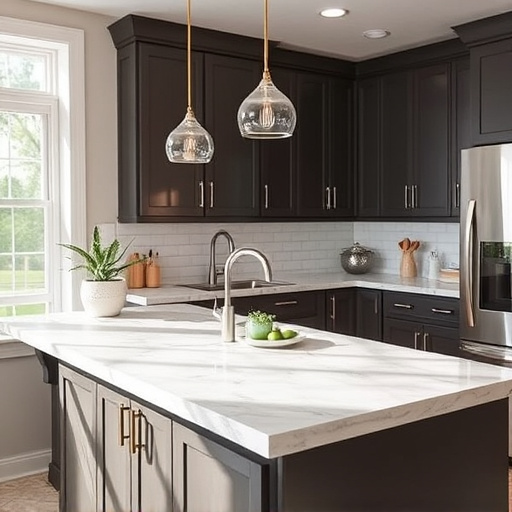Navigating Bathroom Countertops: Material Choices and Selection Tips
Selecting the perfect bathroom countertops involves understanding diverse material options beyond gr…….
In the realm of interior design, few elements capture our attention as instantly as bathroom countertops. These versatile surfaces, serving both functional and aesthetic purposes, play a pivotal role in shaping the ambiance and efficiency of one’s personal sanctuary—the bathroom. From the sleek marble of yesteryear to the innovative smart materials of today, bathroom countertops have evolved significantly over time. This comprehensive article delves into the intricate world of bathroom countertops, exploring their history, global impact, economic significance, technological innovations, regulatory frameworks, and future prospects. By the end, readers will grasp the multifaceted nature of these design elements and their role in transforming spaces.
Bathroom countertops, a staple in modern bathrooms, refer to durable surfaces that cover the tops of various fixtures, including sinks, vanities, and toilets. These countertops serve multiple functions: protecting the underlying surfaces from moisture and damage, providing a sanitary and easily cleanable barrier, and enhancing the overall aesthetics of the space.
The core components typically include:
The concept of bathroom countertops has evolved over centuries, reflecting changes in architectural styles and cultural preferences. Historically, natural stones like marble and granite were reserved for grand public spaces due to their rarity and high cost. However, advancements in extraction techniques and manufacturing processes have made these materials more accessible and affordable, leading to their widespread adoption in homes.
Today, bathroom countertops are not just functional elements but also design statement pieces. They contribute significantly to the overall aesthetics, resale value, and comfort of a home, making them a key consideration for homeowners, designers, and architects alike.
The influence of bathroom countertops extends far beyond national borders, with trends and innovations circulating globally. Several factors shape the trajectory of this industry:
The bathroom countertops market is a vital component of the global construction and home improvement industry, with intricate economic dynamics at play.
Innovation in bathroom countertops has led to remarkable developments that enhance functionality, durability, and design possibilities.
The bathroom countertops industry is subject to various policies and regulations aimed at ensuring product safety, environmental sustainability, and fair trade practices.
Despite their widespread adoption, bathroom countertops face several challenges that require addressing to ensure sustained growth and consumer satisfaction.
In a recent renovation project in New York City, a contemporary apartment bathroom was transformed using a minimalist approach. The design featured a sleek, integrated quartz countertop with clean lines and a smooth finish. The countertop incorporated built-in storage compartments, seamlessly blending functionality with aesthetics. The choice of quartz was driven by its durability, low maintenance, and the ability to create seamless edges, aligning with the modern aesthetic. This case demonstrates how thoughtful material selection and design integration can elevate a bathroom’s overall appeal.
A luxury resort in Bali embraced an eco-friendly approach for its guest bathrooms. The space featured recycled glass countertops with intricate, hand-crafted veining patterns inspired by local natural formations. The choice of material reduced the project’s environmental footprint while creating a serene ambiance. Additionally, low-flow faucets and efficient lighting systems further emphasized the sustainability focus. This case study highlights how bathroom countertops can contribute to a broader sustainability narrative, enhancing the overall guest experience.
A boutique hotel in Paris utilized custom-designed solid surface composites for its unique, art-deco inspired bathrooms. The material allowed for intricate geometric patterns and customized shapes, creating a distinct visual identity. This case showcases the versatility of modern materials, demonstrating how bathroom countertops can become a central design element that defines a space’s character.
The landscape of bathroom countertops is poised for further growth and transformation, driven by emerging trends and technological advancements.
Bathroom countertops, far from being merely functional fixtures, have evolved into multifaceted elements that shape the ambiance, efficiency, and value of our personal sanctuaries. From global trends and economic influences to technological advancements and regulatory frameworks, this industry is a testament to human creativity and innovation. As we look ahead, the future of bathroom countertops promises exciting possibilities, with sustainability, technology, and customization at the forefront.
By understanding the intricate dynamics of this market, designers, homeowners, and manufacturers can make informed decisions that elevate the humble countertop from a functional element to a centerpiece of modern bathroom design.
Q1: What are the common materials used for bathroom countertops?
A: Popular choices include granite, quartz, marble, laminate, solid surface composites, and recycled glass. Each material offers unique advantages in terms of durability, appearance, and maintenance requirements.
Q2: How do I choose the right countertop for my bathroom?
A: Consider your budget, desired aesthetic, maintenance preferences, and the overall design of your space. Research different materials, consult with professionals, and visualize options using digital tools to make an informed decision.
Q3: Are natural stones more durable than synthetic alternatives?
A: While natural stones like granite and marble are renowned for their durability, synthetic materials, such as quartz and engineered composites, offer exceptional strength and resistance to scratches and stains, sometimes surpassing natural stones in certain aspects.
Q4: Can bathroom countertops contribute to energy efficiency?
A: Absolutely! Some materials, like recycled glass and certain composite options, have inherent thermal properties that can help regulate room temperature, reducing the need for additional heating or cooling. Additionally, smart countertops with integrated sensors can optimize water usage in faucets and showerheads.
Q5: How can I clean and maintain my bathroom countertop?
A: Cleaning methods depend on the material. Most surfaces recommend using mild detergents and soft cloths. For natural stones, regular sealing and polishing are essential. Laminate and composite materials often have easy-clean finishes. Always follow manufacturer guidelines for specific care instructions.

Selecting the perfect bathroom countertops involves understanding diverse material options beyond gr…….